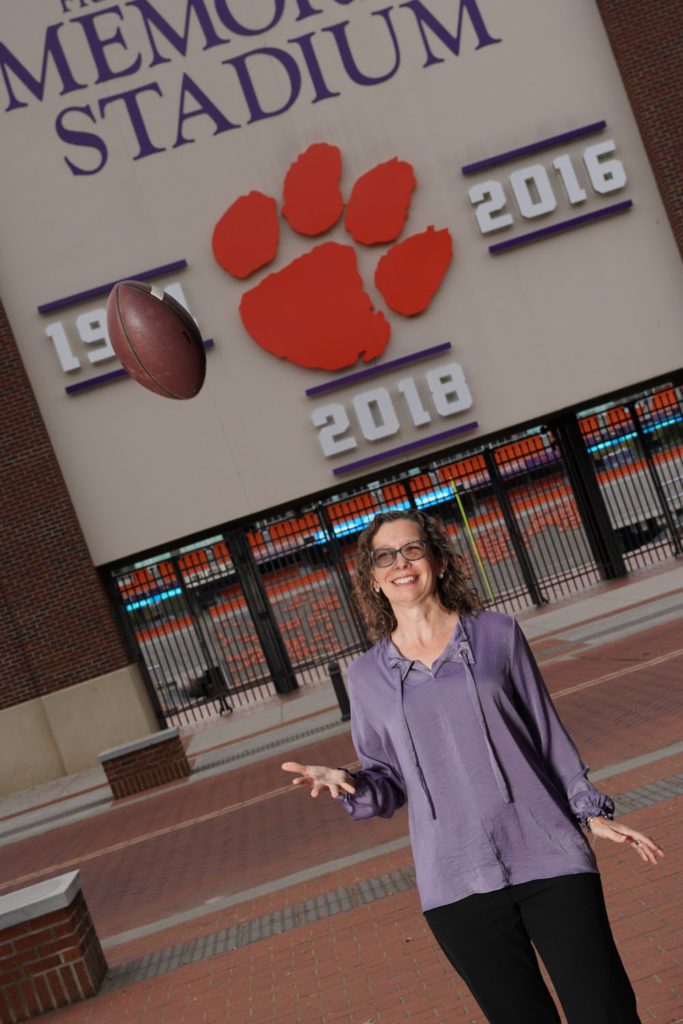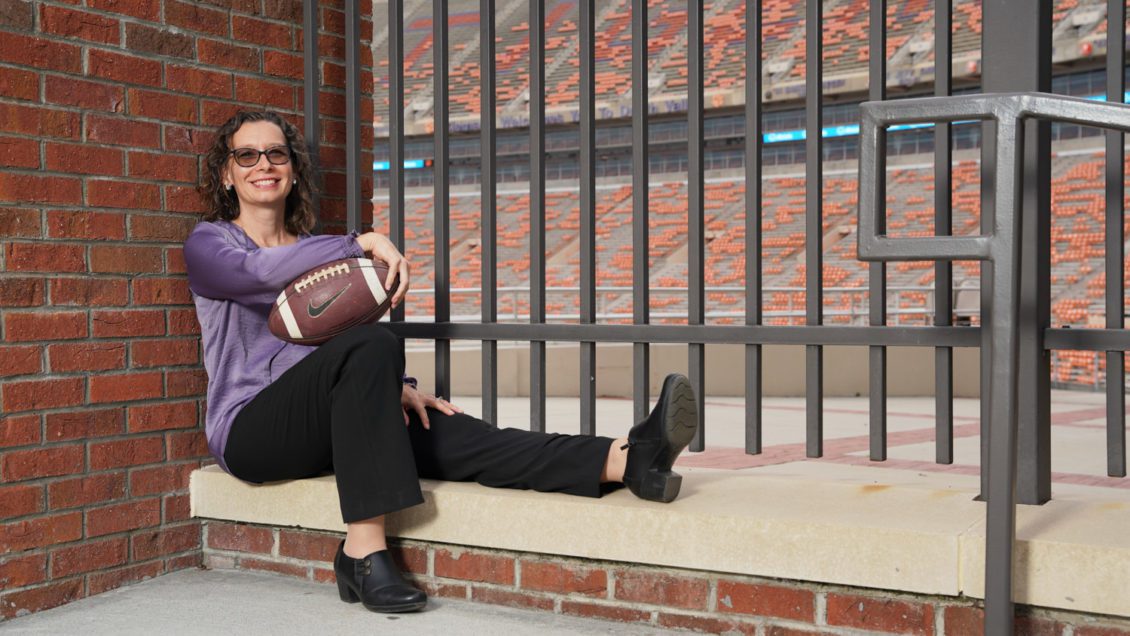When linebacker James Skalski tackled Georgia Tech tight end Dylan Deveney at the 2-yard line on a fourth-and-goal shovel pass in the waning seconds of a September Atlantic Coast Conference game, most Clemson fans saw a game-saving tackle.
Amy Pope, a senior lecturer in Clemson University’s Department of Physics and Astronomy, saw physics in action.
The defensive stop two yards short of the goal line preserved the Tigers’ 14-8 win and provided a breath-stopping example of momentum, acceleration and force. But it doesn’t take a victory-saving tackle to study physics. Each Tiger football game offers thousands of similar opportunities to learn Sir Isaac Newton’s laws of motion or one of the many other laws governing physics.
Physics is prevalent, from the opening kickoff to a potential game-ending field goal. It’s present on that long touchdown throw that hits the wide receiver in stride and brings the crowd to its feet, as well as the pass a defender deflects with a fingertip at the last second for an incompletion.
“Football is a game of physics,” said Pope, who teaches ‘Physics of Sports,’ a general education physics course that uses football, NASCAR, the Olympics and other sports to teach a science that many students fear. “It really should be called a physics game.”
Science of the sport
The football field is where sports and science collide.
Take a long touchdown pass, for instance. For Pope, it’s the perfect opportunity to talk about kinematics, the branch of physics that deals with motion. The same goes for a long field goal attempt.
“If you knew the angle of launch and the velocity of the launch, you can determine the path of the projectile. For field goals, you can look at the ball immediately after it leaves the kicker’s foot, and you can trace the parabolic path as long as nobody jumps in to block it,” she said. “If you could do the calculations quickly enough, you could determine where the ball is going to go.”
When a quarterback hits a wide receiver in stride for a touchdown, that’s physics, too. The quarterback knows the angle at which he must throw the ball to get it to the point on the field where the receiver is running. The receiver knows how long the ball will be in the air to get to that spot, determining the distance and how fast he needs to run. But even before the quarterback lets the pass go, he is using physics. “He’s pulling his arm back and using the muscles in his arm to create an acceleration, which produces that force.”
Physics even plays a role in whether a receiver catches the ball or drops it.
“The receiver has to exert a force on the football if he’s going to catch it,” she said. “We have to look at the coefficient of friction between his hands and the ball. That’s where the gloves a player wears play a role. You want your hands to be kind of sticky if you’re going to catch the ball, right? That’s why a slick, wet ball is difficult to throw and catch because of the low coefficient of friction.”

After the receiver catches the ball, there’s the collision.
“A big part of the game is hitting other people, and what we’re talking about there is momentum. You want your defensive line to be your biggest guys. The reason is that momentum is the mass of the individual times their velocity. If you have a big, heavy guy going fast, you have a large momentum. If he is pitted against a running back or a receiver, who typically has a much smaller mass, they can typically hold them back,” Pope said.
Physics also plays a role in equipment. Helmets, mouth guards and shoulder pads cushion the impact the player is going to experience.
“That’s called impulse, which is the force multiplied by the change in time. So when a player is thrown to the ground, the same amount of force will stop him, whether or not they have padding. But if they have that padding, it is going to cushion the impact and give their head, or whatever body part is striking the ground, a longer time to stop,” she said. “Injuries are mitigated because of that.”
Not an athlete
Pope said she’s the last person who thought she’d be using the gridiron to teach Newton’s laws of motion.
“I have zero coordination, so I haven’t ever played organized sports,” she said. “But I love physics, and I love being able to talk to people about my passion through a passion of theirs.”
One of Pope’s former students, former Tiger long snapper Austin Spence, nominated her as a guest professor for P.A.W. Journey, a program designed to help Clemson Football players to be successful in all aspects of life. The guest professors travel with the football team to take part in a game weekend experience.
Language barrier
She sat in on a defensive meeting, where she listened to Coach Brent Venables talk to his players about the game plan.
“I knew every word he used, but I had absolutely no idea what he was saying. He kept calling guys Mike, and several Mikes would respond. I later figured out Mike was a position, not their actual names,” she said.
She decided that how she felt in that team meeting was probably similar to what her students felt in her class.
“I tell students they already know a lot about physics. They just don’t know it yet,” said Pope, who received her bachelor’s, master’s and doctoral degrees in physics from Clemson. “We participate in it every day. They’ve seen a football being thrown. They’ve watched NASCAR and the Olympics on television. When you’re able to take something that students are comfortable with and connect it to science, it breaks down the barrier of fear that a lot of students have.”
Pope said she tells students her class is going to ruin football for them.
“I tell them they’ll never be able to watch football the same again,” she said.
Get in touch and we will connect you with the author or another expert.
Or email us at news@clemson.edu

